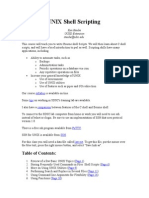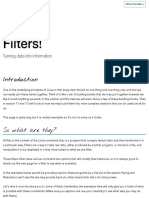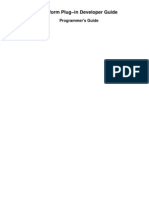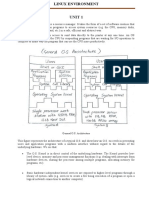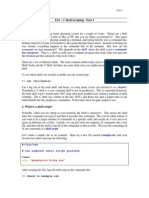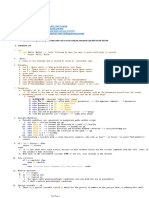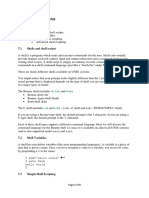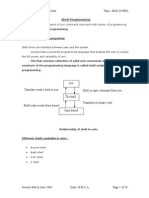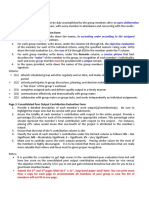Introduction to Advanced UNIX
March 9 2010
Kevin Keay
�Outline
Overview Resources The basic form of a typical C-shell script Introduction to C-Shell Programming Advanced UNIX materials: The following are PDF documents that may be used for reference but wont be discussed in detail during this short course: Part 1 : Scripts Part 2 : A summary of useful software Part 3 : Reanalysis products
Lab session (informal) 2-3 PM UNIX Lab
See:
http://www.earthsci.unimelb.edu.au/~kevin/UNIX_Course/Advanced_UNIX_Lab_Session_2010.pdf
�Overview
This is a practical course that is designed
to give you the basic skills to write UNIX C-shell scripts You can only truly understand the concepts by putting them into practice!
�Overview (2)
We will look at the basic form of a C-shell script There will be a quick tour through Introduction to C-Shell
There are some extra advanced UNIX materials (Parts 1-3)
that you may need to reference. Some aspects will be looked at during the lab session but they are intended for personal reference Part 1 covers C-shell scripts and some additional concepts Part 2 is a summary of some useful software Part 3 focuses on downloading and decoding reanalysis data (NetCDF and GRIB) Finally, there is a short Lab session
Programming
�Resources
A very useful and concise reference book covering UNIX and the C shell is:
UNIX in a Nutshell, OReilly and Associates (Engineering Library: 005.43
GILL).
A useful online resource from the University of Surrey, UNIX Tutorial for
Beginners, is available at: http://www.ee.surrey.ac.uk/Teaching/Unix/
http://www.earthsci.unimelb.edu.au/~kevin/UNIX_Course/ you are using e.g. man awk. However sometimes the pages are not installed or are in an unexpected location. It may be more convenient to use a search engine like Google to find information on a command.
For PDF files of the handouts see:
All UNIX commands should have a manual (man) page on the machine that
�The basic form of a typical C-shell script
The first line of a C-shell script (text file) is:
#!/bin/csh f The f option tells the script not to source (read) the users .cshrc file; this is faster and also makes the script more portable. All other lines starting with # are comments Commands may be continued onto subsequent lines with \ Multiple commands can be placed on a single line with ; Spaces around operators and commands are required but there are no other restrictions
�The basic form of a typical C-shell script (2)
For neatness, end the script with exit (not
Shell variables start with a $ (this is only
essential)
omitted with using set or @ - see below) The shell variable $#argv contains the number of arguments (items) typed on the command line. The items are referred to as shell variables $1, $2, $3, , $#argv
�The basic form of a typical C-shell script (3)
For example:
myscript jja -4.56 yes would give: $#argv = 3 $1 = jja $2 = -4.56 $3= yes
�The basic form of a typical C-shell script (4)
Shell variables are either string (text) or numeric A string variable is set (defined) by:
set var = value e.g. set x = Fred Note: Variables and values are case-sensitive i.e. x is not the same as X Variable names can be several characters e.g. set Case2 = 3 To print (display) the value of a variable: echo $var e.g. echo $x Fred
�The basic form of a typical C-shell script (5)
A numeric variable is set (defined) by:
@ var = integer e.g. @ k = -7 Simple calculations may be performed e.g. @ j = ($k + 1) [j would be 7 + 1 = -6] @ k = ($k + 1) would change k from -7 to -6 Could also use C notation: @ k ++ @ j = (2 * $k - 5) [k= -7 would give j= -19] Note: Put spaces around operators like *, + etc. Floating point operations are not normally used in scripts but can be done with the command bc e.g. echo "2.1 + 6.3" | bc would print 8.4 on the screen set y = `echo "2.1 + 6.3" | bc` would save the answer in variable y
�The basic form of a typical C-shell script (6)
A shell variable may be given the output
of a command (or user program) as in the bc example. In general: set var = `command` e.g. set ff = `ls *.dat` Remember: ls is used to list files. If the files are 5.dat 12.dat 13.dat then echo $ff would display: 5.dat 12.dat 13.dat
�The basic form of a typical C-shell script (7)
To extract the individual elements of
variable ff we can use $#ff to find the number of items (similar to $#argv) e.g. echo $#ff would display 3 echo $ff[1] would display 5.dat echo $ff[2] would display 12.dat echo $ff[3] would display 13.dat
�The basic form of a typical C-shell script (8)
A while loop is used to set up an iterative or
repetitive procedure: while (condition is true) commands end e.g. @ k = 1 while ($k <= 3) echo $k @ k = ($k + 1) end
# Initialise k # Process loop while k <= 3 # Display k # Increment k by 1
�The basic form of a typical C-shell script (9)
A foreach loop is used to set up an iterative or
repetitive procedure involving files: foreach var (files) commands end e.g. foreach f ([A-Z]*) # f is a file starting with a capital letter echo $f # Print filename mv $f $f.cap # Rename file to have extension .cap end
�The basic form of a typical C-shell script (10)
An if-else-endif structure is used to control script
branching: if (condition 1 is true) commands else if (condition 2 is true) commands else commands endif Note: use else if` not elseif
�The basic form of a typical C-shell script (11)
e.g.
if ($x == 6 || $s == sea) then
do something
else if ($x > 10) then
do something else
else
go here if neither of the above conditions is true
endif Simpler or more complex forms are possible e.g. if ($y == 2) ls l *.dat
�The basic form of a typical C-shell script (12)
The while or if (condition) uses C notation
for logical operations: || or && and == equal >= greater than or equal <= less than or equal != not equal > greater than < less than
�The basic form of a typical C-shell script (13)
An example
#!/bin/csh f if ($#argv != 1) then echo Usage: myscript name exit # If incorrect usage end the script else # If only 1 argument, branch here set n = ($1) # Put n equal to $1 endif echo Your name is $n
# You could do other things here
exit
�The basic form of a typical C-shell script (14)
Another example
#!/bin/csh f set ff = `ls *.dat`
# ff contains filenames *.dat @ nf = $#ff # nf equals the no. of files (items in ff) @j=1 # Set counter j to 1 while ($j <= $nf) # Loop while j <= nf set f = $ff[$j] # Set f to be the jth file ls l $f # List the details of f # We could use the file f as an argument to a command or program
myprog $f @j = ($j + 1) # Increment counter j by 1 end # Go here when j > nf echo We are finished! # A message to the screen
exit
�Introduction to C-shell programming
Refer to the PDF guide:
http://www.earthsci.unimelb.edu.au/~kevin /UNIX_Course/Intro_to_CShell_Programming_2008.pdf
�Advanced UNIX materials
The following are PDF documents that
may be used for reference but wont be discussed in detail during this short course: Part 1 : Scripts Part 2 : A summary of useful software Part 3 : Reanalysis products
�Lab session
Lab session (informal) 2-3 PM UNIX
Lab See:
http://www.earthsci.unimelb.edu.au/~kevin/UNIX _Course/Advanced_UNIX_Lab_Session_2010.pdf
